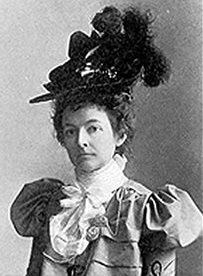Susie Frances Harrison facts for kids
Quick facts for kids
Susie Frances Harrison
|
|
|---|---|
 |
|
| Born | Susan Frances Riley February 24, 1859 Toronto, Ontario |
| Died | May 5, 1935 (aged 76) Toronto, Ontario |
| Pen name | Medusa, Seranus, Gilbert King |
| Occupation | Composer, writer, pianist |
| Language | English |
| Nationality | Canadian |
| Citizenship | British subject |
| Notable works | Pine, Rose, and Fleur-de-Lys |
| Spouse | J.W.F. Harrison |
| Signature | |
 |
|
Susie Frances Harrison (born Riley, February 24, 1859 – May 5, 1935) was a talented Canadian writer, poet, and music composer. She was also known by her pen names, like Seranus. Susie Harrison lived and worked in important Canadian cities like Ottawa and Toronto.
Contents
Susie Harrison's Early Life and Music
Where Was Susie Harrison Born?
Susie Frances Riley was born in Toronto, Ontario. Her family had Irish roots in Canada. She was the daughter of John Byron Riley.
How Did Susie Harrison Learn Music?
Susie loved music from a young age. She studied music with a teacher named Frederic Boscovitz. She went to a private school for girls in Toronto. Later, she continued her music studies in Montreal.
Susie Harrison's First Steps as a Writer
When she was just 16, Susie started publishing poetry. Her poems appeared in a newspaper called the Canadian Illustrated News. She used the pen name "Medusa" for these early works. After finishing school, she worked as a pianist and singer.
Susie Harrison's Family Life
In 1880, Susie married John W. F. Harrison. He was an organist from Bristol, England. John was the organist at St. George's Church in Montreal. Susie and John had a son and a daughter together.
Susie Harrison's Career in Ottawa and Toronto
Life in Ottawa
In 1883, the Harrisons lived in Ottawa. Susie Harrison composed a special song there. It was called "Address of Welcome to Lord Lansdowne." This song celebrated the first public appearance of the new Governor General, the Marquess of Lansdowne.
Moving to Toronto and a New Pen Name
In 1887, the Harrison family moved to Toronto. John Harrison became the organist and choirmaster at St. Simon the Apostle church. Susie Harrison began her writing career more seriously. She started using the pen name "Seranus." This name came from a mistake in reading her signature, which was "S. Frances." Soon, she was publishing articles in many important newspapers and magazines.
Susie Harrison's Music Compositions
Susie Harrison wrote many songs. Some were published in the United States and England under her name Seranus. She also published other songs in England using the name Gilbert King.
Susie Harrison as a Music Expert
Susie Harrison was a music critic for The Week magazine. She wrote about music from December 1886 to June 1887, using her Seranus pen name. She also wrote a "Historical sketch on Canadian music" for a big book called Canada: An Encyclopedia of the Country in 1898.
She was known as an expert on folk music. She often gave talks about it. She used old Irish tunes in her String Quartet on Ancient Irish Airs. She also used French-Canadian music in her 1887 work, Trois Esquisses canadiennes (Three Canadian Sketches). This work included pieces called 'Dialogue,' 'Nocturne,' and 'Chant du voyageur'. She even used French-Canadian melodies in her three-act opera, Pipandor.
Her String Quartet on Ancient Irish Airs is thought to be the first string quartet written by a woman in Canada. In 1896 and 1897, she gave popular talks in Toronto about "The Music of French Canada."
Susie Harrison as a Music Educator
For 20 years, Susie Harrison was the principal of the Rosedale branch of the Toronto Conservatory of Music. In the 1900s, she helped edit and wrote for the Conservatory's magazine, Conservatory Monthly. She also wrote for its next magazine, Conservatory Quarterly Review. She wrote the article about "Canada" for the 1909 Imperial History and Encyclopedia of Music.
Besides all this, she wrote at least six books of poetry and three novels.
Susie Harrison's Writing Style
What Was Susie Harrison's Poetry Like?
Susie Harrison's music training showed in her poetry. She was very good at using different rhythms in poetic forms like the sonnet and the villanelle. Like other Canadian poets of her time, she wrote about nature, love, and being proud of her country. Her poems about landscapes were influenced by other famous poets. She described the Canadian wilderness as beautiful but also mysterious.
Harrison was especially skilled at writing villanelles. This was a French poetry style that became popular in English.
What Were Susie Harrison's Novels About?
Her two novels showed her interest in Quebec culture. She shared this interest with many English-speaking Canadians of her time. Her novels often had a dark, "gothic" feel. They included themes of horror, madness, old manor houses, and a certain type of Catholicism. Harrison wrote about a past time in a way that made it seem romantic. This helped Canadians feel they had a special history.
Recognition for Susie Harrison
Over time, Susie Harrison's fame decreased. In 1916, a writer named John Garvin called her "one of our greater poets whose work has not yet had the recognition in Canada it merits." But by 1926, Garvin simply called her "one of our distinctive poets."
In 1990, the Dictionary of Literary Biography wrote about Susie Frances Harrison. It said that her unpublished works were not saved. Her published works were hard to find. It noted that her important place in Canadian literature was almost forgotten.
Images for kids

